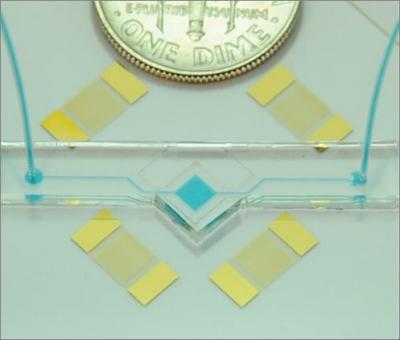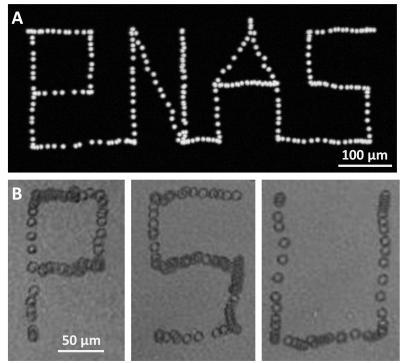University Park, Pa. -- A device about the size of a dime can manipulate living materials such as blood cells and entire small organisms, using sound waves, according to a team of bioengineers and biochemists from Penn State.
The device, called acoustic tweezers, is the first technology capable of touchlessly trapping and manipulating Caenorhabditis elegans (C. elegans), a one millimeter long roundworm that is an important model system for studying diseases and development in humans. Acoustic tweezers are also capable of precisely manipulating cellular-scale objects that are essential to many areas of fundamental biomedical research.
Acoustic tweezers use ultrasound, the same noninvasive technology doctors use to capture images of the fetus in the womb. The device is based on piezoelectric material that moves when under an electrical current. The vibrations pass through transducers attached to the piezoelectric substrate, where they are converted into standing surface acoustic waves (SAWs). The SAWs create pressure fields in the liquid medium that hold the specimen. The simple electronics in the device can tune the SAWs to precisely and noninvasively hold and move the specimen or inorganic object.
"We believe the device can be easily manufactured at a cost far lower than say, optical tweezers, which use lasers to manipulate single particles," said Tony Jun Huang, associate professor of bioengineering, whose group pioneered acoustic tweezers. "Optical tweezers require power densities 10,000,000 times greater than our acoustic tweezers, and the lasers can heat up and damage the cells, unlike ultrasound."

This is the miniaturized ultrasonic device capable of capturing and moving single cells and tiny living creatures is compared to a US dime.
(Photo Credit: Xiaoyun Ding, Stephen J. Benkovic, and Tony Jun Huang)
For many biological systems, acoustic tweezers will provide an excellent tool to mimic the conditions inside the body where cells are subject to waves of pressure and pulses of chemicals. The researchers published their results in this week's online edition of the Proceedings of the National Academy of Sciences.
"Acoustic tweezers will be used to position cells for interrogation by pulses of drug-like molecules to test as well as to exert mechanical forces on the cell wall," according to Stephen Benkovic, Evan Pugh Professor of Chemistry and holder of the Eberly Family Chair in Chemistry, whose group contributed to the paper, "The cells will contain bio-chemical markers, so we can observe the effect of drug pulses or pressure on the cell's biochemistry."
Acoustic tweezers are very versatile, said Huang. "We can manipulate a single cell or we can manipulate tens of thousands of cells at the same time."
Currently, the size of objects that can be moved with acoustic tweezers ranges from micrometers to millimeters, although with higher frequencies, it should be possible to move objects in the nanoscale regime, the researchers believe. Further work will include modifying the device to accommodate more fundamental biomedical studies with the Benkovic group.
Ultimately, the patent pending technology could lead to compact, noninvasive and inexpensive point-of-care applications, such as blood cell and cancer cell sorting and diagnostics. For now, the ability to trap and manipulate a living C. elegans for study is proof of their device's potential utility.

This is a schematic of an acoustic tweezers device.
(Photo Credit: Xiaoyun Ding, Stephen J. Benkovic, and Tony Jun Huang, Penn State)
Source: Penn State